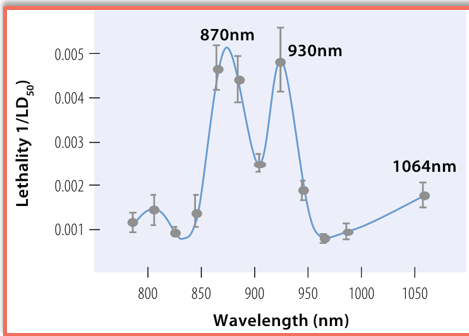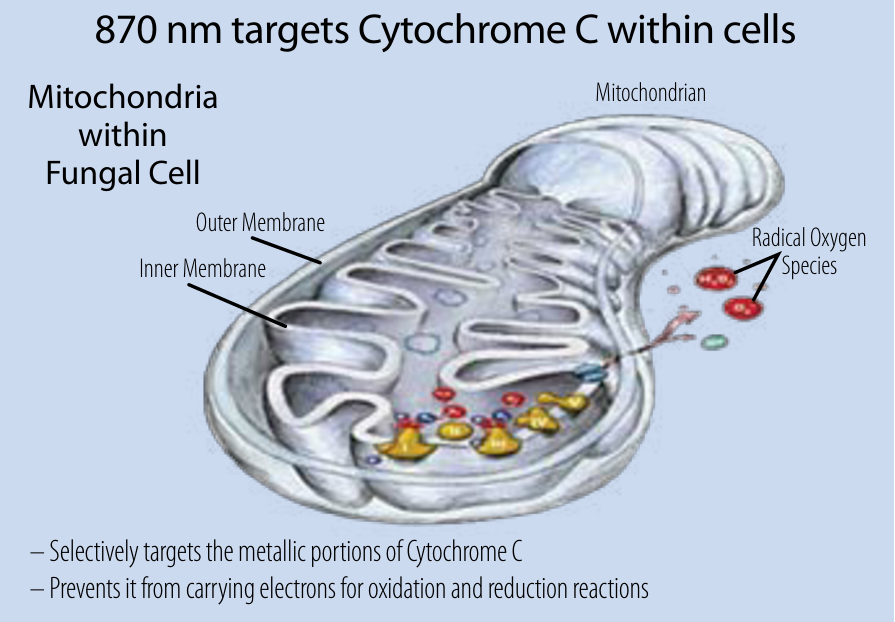How it Works
Laser Light Wavelengths
The Noveon NailLaser treat ment’s two
light wavelengths (870nm/930nm) are
uniquely selected to penetrate below the
tissue surface, while preserving healthy
tissue.
Vertical axis measures fungal sensitivity to
light energy. Metric is 1—LD50. LD50 is the
dosage required to kill 50% of a test
population. Higher value indicates higher
lethality.
Characterization of Photo damage to
Escherichia coli in Optical Traps; KC Neuman,
EH Chadd, GF Liou, et al, Biophysical Journal,
November 1999
* The light energy selectively targets fungal
cells
* Mammalian and fungal cells have
different biochemistry
* Healthy mammalian cells are more
resilient and can cope with the light energy
* Fungal cells are less resilient and they
break down
* Entire process is photo-biologic with
minimal heat
* 870nm and 930nm wavelengths are more
lethal to fungus
• Effect first identified by Neuman
• Dr. Eric Bornstein, Nomir’s founder,
advanced the research
• The Noveon NailLaser is the first
commercial product to exploit the
wavelengths
• Small wavelength variations dramatically
reduce lethality
• 1064nm (Nd:YAG) – 40% as lethal
• 800, 810, 940, 970, 980nm also
dramatically less lethal to fungus
* The two wavelengths of the Noveon
NailLaser cause a similar type of damage,
but to different parts of fungal cells
• 870nm targets Cytochrome C within cells
• 930nm targets fungal cell membrane
* Both wavelengths cause radical oxygen to
accumulate inside the fungal cell
• Oxygen is a normal byproduct of cell
metabolism
• Normally, the oxygen is converted into
water (H2O) and expelled
• The light energy emitted by the Noveon
NailLaser blocks the formation of H2O
which causes radical oxygen to accumulate
• Radical oxygen is highly unstable and
reacts with anything that’s nearby
• As the radical oxygen reacts with other
molecules, it destroys the fungal cell
Heat vs. Photobiology
Nd:YAGs use ‘Gaussian’ beams – narrow,
high intensity beam with a very hot center.
Typical beam diameter is just 1-5 mm.
• Energy distribution is very uneven
• Center gets intensely hot
• Hard to achieve uniform dosage
The Noveon NailLaser uses ‘flat top’ beam
• Delivers uniform energy across nail surface
• No part of beam gets hot
• Easy to achieve uniform dosage
Noveon NaiLaser Treatment Protocol
Individual Session
● Average session takes 20 minutes
• 16-minute laser cycle + 5 mins for
ingress/egress
• Toes treated in batches of up to 4 at a time
• Only infected toes are treated
● Simple procedure
• Attach toepods to infected toes only
• Connect emitters
• Activate automated laser algorithm
• If more than 4 toes, repeat steps 1 to 3
● No attendant required during operation
Noveon NaiLaser Performance
Three advantages that impact usability,
patient comfort and safety
Compared to other laser options, the
Noveon NailLaser treatment is unique:
Operating mode: Automatic or manual?
Automatic operation delivers consistent
light dosage more accurately, freeing up
staff time, and eliminating operator errors
resulting from painstaking repetitive motion.
Method of action: Does the laser attack
fungal cells using heat or photobiology?
Nd:YAG lasers attack fungus using heat,
resulting in likely pain for patients, and laser
fumes which are unpleasant and unhealthy
for physician and patient.
The Noveon NailLaser uses photobiology,
delivering better results without the risk of
excessive heator laser plume.
Light wavelengths: The unique wavelengths
used by the Noveon NailLaser – 870nm
and 930nm – are 2.5x more lethal to fungus
than the 1064nm light from an Nd:YAG laser.





